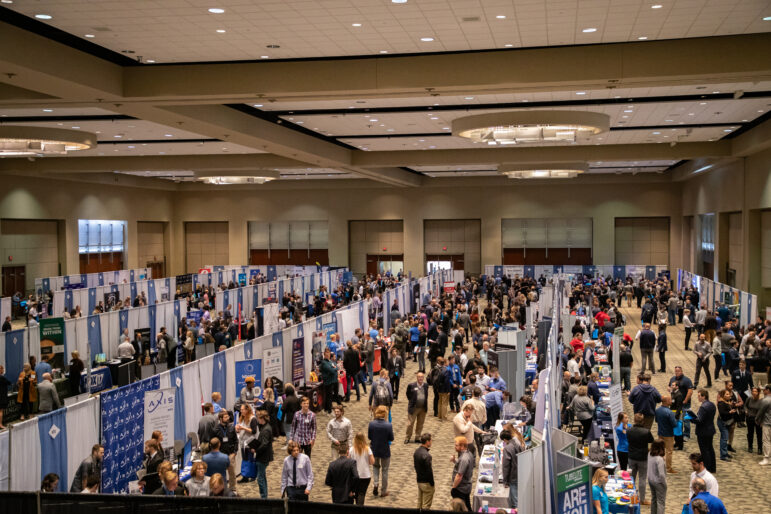
Grand Valley State University
Students attend a recent job fair at Grand Valley State University.By ANISH TOPIWALA
Capital News Service
LANSING – After the COVID-19 pandemic forced employers to shift to a virtual recruitment strategy, there’s now a shift back to the on-campus hunt at Michigan universities for new employees .
The National Association of Colleges and Employers reported more than 91% of 204 employers surveyed across the country used on-campus recruiting to find 2022 graduates.
Recruiters have become tired of the virtual alternatives and are eager to move back to in-person options, according to employers who work with the recruitment organization Michigan Career Educator and Employer Alliance.
“We’re burnt out in the virtual,” said Korina Kasperek, the president-elect of the educator and employer group. “We’re all at the point where we can go back and start interacting with students.”
“We want to have that face-to-face connection,” said Kasperek, who is a supervisor of human resources at DTE Energy, as well as a recruiter for the utility company.
Her nonprofit organization works with employers and schools to provide information and opportunities regarding recruitment events.
“Through knowledge-sharing and networking we’re able to enhance our efforts that eventually trickle down to the student,” Kasperek said.
Virtual alternatives to career fairs were limiting and didn’t allow for the flexibility and physical interaction which on-campus recruitment has, said Kasperek.
The shift back to in-person recruitment also enables employers to reach students through other methods.
For example, some schools allow recruiters to give presentations to relevant classes, according to Kasperek.
The move back to in-person recruitment also allows student groups to reach out to employers for information regarding opportunities.
“We’re seeing companies invest more in those clubs and organizations. Being able to meet specifically with specific majors tends to have a higher return on investment than an all-school fair,” said Joe Bamberger, the organization’s current president and the founder and managing partner of Emerge.
Emerge is a Royal Oak-based organization that builds connections between employers and students. The group works with mostly small to medium market-size companies that lack the resources or capability to reach every college campus, Bamberger said.
“This allows them to pull their resources together and punch above their weight class, so to speak,” Bamberger said.
Bamberger also stresses the importance of in-person recruitment.
“I am of the mindset that if I have two resumes in front of me and they look similar on paper and I have met one of the students in person, I am always giving the advantage to the person I’ve met,” Bamberger said.
One school moving back heavily to on-campus recruitment is Grand Valley State University.
The majority of its career servicing events since the fall of 2022 have been in-person, said Cindy Brown, Grand Valley’s employment development manager.
“We have a waiting list of employers for both of our big career fairs,” Brown said.
Of its two large annual career fairs, the fall event with over 230 employers usually sells out two months in advance, according to Brown.
Its Feb. 22 career fair sold out in early January.
“We’re seeing a lot of our employers want to get back to in-person,” said Brown. “They want to meet with students. They want to be on campus.”
Virtual recruitment events still occur at Grand Valley, but they’re a minority.
Brown said a large number of engineering firms attend the large fairs.
Other large concentrations of employers focus on business students, health care, human and public service, communications, public relations, advertising, marketing and sales.
Grand Valley also hosts smaller, more targeted events for specific majors.
The university has a high proportion of students who stay in Michigan. Its First Destination Survey, which ended in June 2022, found that 85% of graduates live and work in the state.
Brown said that a large portion of employers visiting Grand Valley are headquartered in Michigan.
Looking at how career fairs have changed since the COVID-19 pandemic, Brown said some students who had never attended one in person have had trouble adjusting.
“They might not have understood how to work a career fair in person,” Brown said.
Another school that has seen a shift to primarily in-person recruitment events is Saginaw Valley State University.
Saginaw Valley has held six in-person employment fairs in the last year, with two larger university-wide events and smaller events concentrated on specific fields.
Its most recent fair on Feb. 2 hosted around 120 companies with an estimated 300 students attending, according to Sarah Binder, the employer and student development specialist at Saginaw Valley.
“There’s much more room for organic connections at the in-person fairs,” said Binder.
However, one hurdle that universities have faced is student engagement with these fairs.
“I think everyone post-COVID has gone through a student engagement challenge,” said Binder.
Binder said Saginaw Valley students prefer the smaller, more informal events with employers.
With larger fairs, Saginaw Valley continues to face challenges.
“We try to avoid too many gimmicks with it because we want students to understand how important this is for their future and to feel that intrinsic value on their own,” said Binder.
Even with fewer students attending, employers have been flexible.
“Even if we only get five students, they’re very open to that,” said Binder. “A lot of them are leaving with great connections.”